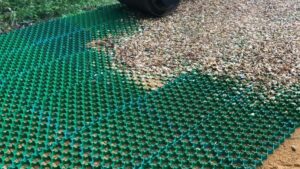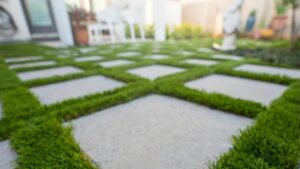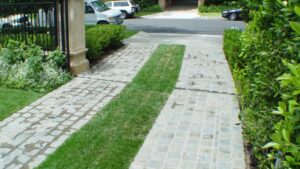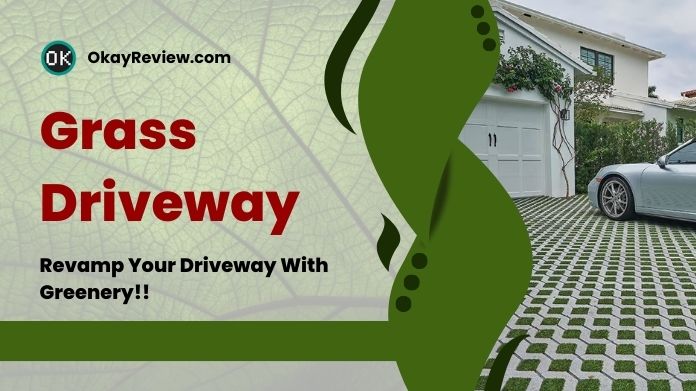Have you ever wondered if there’s a greener, more eco-friendly way to pave your driveway? Look no further because a grass driveway might be just what you’re searching for!
A grass driveway is an innovative solution that combines the functionality of a concrete surface with environmental advantages.
You may construct a driveway that not only looks beautiful but also helps with stormwater management and lessens the load on drainage systems by employing a grid-like system or interlocking pavers intended to support grass or other ground cover.
So, if you’re ready to embark on a journey toward a greener and more sustainable driveway, let’s dive with Okayreview and discover how to build your grass driveway!
Table of Contents
What is Grass Driveway?
A grass driveway, also known as a grass paver driveway or grass reinforcement system, is a more environmentally friendly option than standard driveways.
It employs a grid-like structure of interlocking plastic or concrete pavers designed to assist grass or plant growth.
The open cells in these pavers allow grass to grow through, giving structural support and minimizing soil compaction.
Grass driveways have several advantages. They blend in with the surroundings and assist in stormwater management by letting precipitation absorb into the soil.
Additionally, they boost environmental health through natural filtration and reduce heat island effects.
Proper installation and care, including regular mowing and erosion control, are critical for grass driveway longevity.
Consulting professionals can ensure a suitable installation tailored to specific geographical and environmental conditions.
What Are the Types of Grass Driveways?
1. Plastic Grids
 Plastic grid systems are installed and filled with gravel or sand/soil mixture and grass.
Plastic grid systems are installed and filled with gravel or sand/soil mixture and grass.
These grid systems, mostly recycled plastic, prevent soil compaction and rutting, protecting water quality.
They are composed of honeycomb-like grids of closed plastic cells. Concrete and Grass Concrete and grass are popularly known as grass pavements.
It is made up of a system of carefully molded concrete slabs with ample space for the growth of turf. They allow easy drainage of stormwater to the soil.
2. Grass and Paver
 Grass block paving stones also go by the names turf block paving stones or grow-through paving stones.
Grass block paving stones also go by the names turf block paving stones or grow-through paving stones.
They contain open cells that allow grass to grow through them.
They are an absorbent, environmentally beneficial choice for parking lots and roads.
3. Ribbon Driveway
 Ribbon roads, also known as Hollywood driveways.
Ribbon roads, also known as Hollywood driveways.
They are often built out of two parallel tracks separated by an unpaved part made of durable material.
These ribbon-like tracks are normally a few feet wide with a three-foot space between them, although the widths may be changed to suit vehicles of varying sizes.
Why Are Grass Driveways Gaining Popularity?
As the popularity of grass driveways grows, homeowners and landscapers are becoming more aware of their multiple advantages.
By adding a grass driveway to your property or landscape, you not only get practical usefulness but also help to make the environment greener.
Being surrounded by green areas has improved our mental health, children’s development, and general well-being.
1. Better Stormwater Drainage
Stormwater infiltration improves soil health, decreases runoff and floods, and protects groundwater.
Traditional solid surfaces, such as asphalt and concrete, prohibit water from soaking into the soil, resulting in pollution in streams and bodies of water.
A grass road allows water to absorb and filter, reducing pollutants and conserving water. Improving stormwater drainage using grass roads helps to protect the environment and promotes healthier ecosystems.
2. Provide a Cooler Ambiance
Allow refreshing air and water to circulate through porous surfaces to create a cooler ambiance.
It encourages planting, improves vistas with a live tree canopy, and makes the atmosphere more pleasant and visually pleasing.
3. View of Environment
Using grass instead of asphalt or concrete can greatly cut cooling costs and carbon emissions. Because cities retain heat, they can become several degrees warmer than the surrounding countryside.
We can harness the cooling effect of grass and reduce the urban heat island effect by using grass surfaces.
This environmentally friendly method provides a cleaner environment, cheaper energy expenses, and a lesser carbon footprint.
How to Build a Grass Driveway?
- Check that it is safe to dig where you are. Contact the utility company to validate this information.
- Depending on the expected load and drainage needs, begin digging at the street-grade level in your designated area. Then lower yourself around six inches.
- Spend time assessing your property’s slope and the retention space needed beneath the grass paver system.
- Tamp the ground and build the sub-base with a tamper.
- Ensure the grid completely encloses the space and is at least an inch below ground level.
- When the grid has been completely immersed and put out, fill the hollow space with loam soil and level it out with a rake. Watering the grid system helps to reduce soil compaction.
- Finally, plant a grass seed or turf in the grids.
Our Thoughts
So, now you’re equipped with all the knowledge you need to create your grass driveway!
By choosing this eco-friendly and visually appealing alternative, you’ll not only enhance the aesthetic appeal of your property but also contribute to stormwater management and the overall health of the environment.

